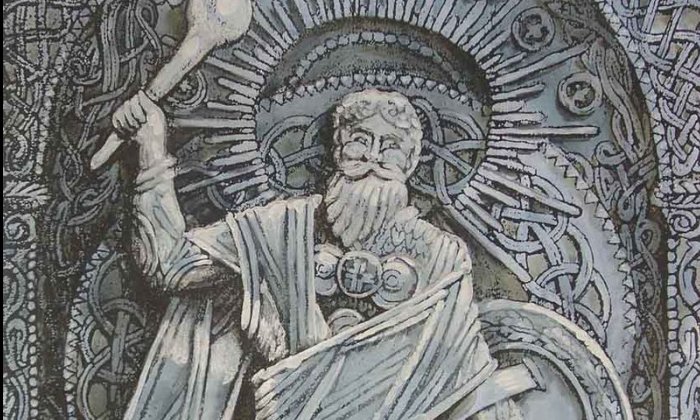Veles And Perun: Most Powerful Slavic Gods In Conflict Between Powers Of Light And Darkness
A. Sutherland - AncientPages.com - Veles represents one of the most important Slavic gods, (another is his own brother and adversary, Perun, God of Heaven and Lightning).
Mentioned in numerous myths and legends of the Slavs especially inhabitants of the Czech Republic, Poland, and Russia, they are both involved in conflicts of powers of Light and Darkness and still, their relationship is of great importance for the planet’s survival.
Veles with a cow's head on his chest on the model of the Millennium of Russia monument. Image credit: shakko - CC BY-SA 3.0
Veles, on the other hand, was a powerful ruler of Nav, the land of the dead, which is a Slavic underworld. It was believed that he had the ability to transform into a snake, and was a guardian to the underworld.
In the underworld, Veles was a shepherd of human souls, but like many other deities of the Slavic pantheon, he was multifunctional. Different aspects of this mythological figure deeply influenced the beliefs of ancient Slavs.
In some myths and legends, as a god of peasants and a chief guardian of cattle, Veles had abilities to effectively protect the herd from wild animals, especially wolves. In ancient times, people used to make offerings to Veles, in form of the last bunch of ears, which was called the “Veles beard”.
He usually appeared as an old man with a long gray beard, but sometimes also as a black goat. It was believed that he lived in the center of the inaccessible wetland located in the underground realm of the dead and his throne was at the root of the sacred tree.
People swore by his name because he was also a god of law and oaths, art and craft, but at the same time, he practiced magic, trickery, foretelling, and supernatural phenomena. He also punishes oath-breakers with diseases, while his brother, god Perun, a ruling god of war, punishes by death in battle.
Veles has been always considered to be a complex mythological figure especially regarding his origin and the role he played in the ancient beliefs of the Slavs. Many different and contradicting features of this enigmatic deity, show his significance and meaning in the pantheon.
Veles is a very charismatic god but so is his brother and eternal opponent, Perun, the supreme god of the Slavic Pantheon as well.
M. Priesniakow (1998). Perun. Image credit: Max presnyakov - CC BY-SA 3.0
The god’s name “Perun” is associated with thunder (in Polish: piorun) and other attributes such as hail, rain, honor, masculinity, mountain, horse, fire, stone, and later metal weapons (hammer, ax, arrow).
His other attribute of great importance is oak, which is widely regarded as the sacred Slavic tree - the focal point of the axis mundi - the axis of the world.
The Slavic oak represents the connection between Heaven and Earth like Yggdrasil in Norse mythology and Ceiba Tree of Maya.
The concept is universal and adopted by religions and cosmologies of many cultures around the world.
Perun and Veles are two of the most important gods in the Slavic pantheon. Perun represents the skies, and Veles represents earth.
These gods are so extremely different that they contradict each other and participate in a never-ending battle. Perun wields his ax from the skies and shoots powerful thunderbolts to the earth, where Veles lives usually in the form of a dragon/snake, and steals Perun’s possession.
One myth mentions Veles steals Jarilo, a son of Perun from the cradle, and brings him to the underworld. Veles raises him as his son. In the springtime, Jarilo returns from the land of the dead, (according to the Slavic beliefs is located beyond the sea) and brings spring from the ever-green underworld into the realm of the living.
The problem is that Jarilo, the god of fertility, vegetation, and spring must be stolen. If this event does not happen, no spring season arises on earth. The battle between Veles and Perun is hopeless because it can never end; these two gods can never meet; heaven and earth are meant to be apart forever and never touch each other.
This conflict will never cease.
Written by – A. Sutherland AncientPages.com Staff Writer
Copyright © AncientPages.com All rights reserved. This material may not be published, broadcast, rewritten or redistributed in whole or part without the express written permission of AncientPages.com
More From Ancient Pages
-
 New Cosmic Ray Bombardment Of The Great Pyramid – Search For The Hidden Chamber Continues
Archaeology | Jan 20, 2020
New Cosmic Ray Bombardment Of The Great Pyramid – Search For The Hidden Chamber Continues
Archaeology | Jan 20, 2020 -
 Sacred Medicine Bundle With Relics Of The First Ancestors Or Given By The Gods
Ancient Traditions And Customs | Sep 15, 2016
Sacred Medicine Bundle With Relics Of The First Ancestors Or Given By The Gods
Ancient Traditions And Customs | Sep 15, 2016 -
 1,000 Bog Bodies From Across Scandinavia Reveal More Ancient Secrets – Here’s What Scientists Found
Archaeology | Mar 20, 2023
1,000 Bog Bodies From Across Scandinavia Reveal More Ancient Secrets – Here’s What Scientists Found
Archaeology | Mar 20, 2023 -
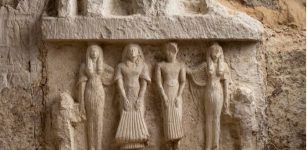 Impressive Ancient Underground Tombs And Chapels Unearthed In Saqqara, Egypt
Archaeology | Apr 16, 2023
Impressive Ancient Underground Tombs And Chapels Unearthed In Saqqara, Egypt
Archaeology | Apr 16, 2023 -
 Who Was The Woman Buried With 25 Warrior Monks Of The Order Of Calatrava At The Castle At Zorita De Los Canes, Guadalajara?
Archaeology | Jun 4, 2024
Who Was The Woman Buried With 25 Warrior Monks Of The Order Of Calatrava At The Castle At Zorita De Los Canes, Guadalajara?
Archaeology | Jun 4, 2024 -
 Seven New Ancient Buddhist Caves – One With ‘A Harmika’ – Discovered In Mumbai
News | Jan 19, 2016
Seven New Ancient Buddhist Caves – One With ‘A Harmika’ – Discovered In Mumbai
News | Jan 19, 2016 -
 Vikings Brewed Beer With Heated Stones – Old Tradition Popular In Germany, Finland And Baltic States
Archaeology | Dec 14, 2017
Vikings Brewed Beer With Heated Stones – Old Tradition Popular In Germany, Finland And Baltic States
Archaeology | Dec 14, 2017 -
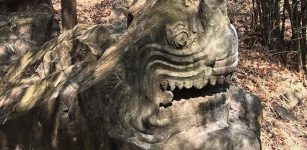 Ancient Statue Of Makara, Legendary Sea-Creature Found In Cambodia
Archaeology | Jan 29, 2020
Ancient Statue Of Makara, Legendary Sea-Creature Found In Cambodia
Archaeology | Jan 29, 2020 -
 Island Archaeology Could Be A Model For Space Exploration
Archaeology | Nov 14, 2022
Island Archaeology Could Be A Model For Space Exploration
Archaeology | Nov 14, 2022 -
 Easter Island May Offer Proof Of An Alien Apocalypse
Archaeology | Jun 7, 2018
Easter Island May Offer Proof Of An Alien Apocalypse
Archaeology | Jun 7, 2018 -
 Ancient Mystery Of Peculiar Nail With Six Faces And Six Eyes – Unusual Discovery In Borgholm Castle, Sweden
Artifacts | Jan 8, 2017
Ancient Mystery Of Peculiar Nail With Six Faces And Six Eyes – Unusual Discovery In Borgholm Castle, Sweden
Artifacts | Jan 8, 2017 -
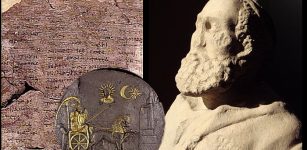 Lost Ancient Greco-Bactrian Kingdom Of 1,000 Cities
Civilizations | Apr 23, 2016
Lost Ancient Greco-Bactrian Kingdom Of 1,000 Cities
Civilizations | Apr 23, 2016 -
 Roman Ship Cargo And Galley Equipment Discovered Underwater In The Caesarea Harbor
Archaeology | Sep 12, 2023
Roman Ship Cargo And Galley Equipment Discovered Underwater In The Caesarea Harbor
Archaeology | Sep 12, 2023 -
 Scientists Explore How Neanderthals Caught Birds In Caves For Food
Archaeology | Sep 16, 2021
Scientists Explore How Neanderthals Caught Birds In Caves For Food
Archaeology | Sep 16, 2021 -
 Ancient Cave Church Complex In Basarabi, Romania
Civilizations | Dec 11, 2018
Ancient Cave Church Complex In Basarabi, Romania
Civilizations | Dec 11, 2018 -
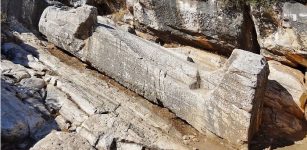 Enigma Of Giant Statue Of Kouros Of Apollonas
Featured Stories | Jul 18, 2019
Enigma Of Giant Statue Of Kouros Of Apollonas
Featured Stories | Jul 18, 2019 -
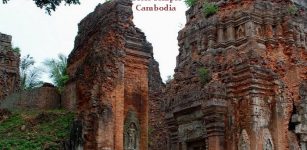 Ancient Wall Of Lolei Temple Built In 893 BC Unearthed In Siem Reap, Cambodia
Archaeology | Apr 20, 2020
Ancient Wall Of Lolei Temple Built In 893 BC Unearthed In Siem Reap, Cambodia
Archaeology | Apr 20, 2020 -
 Ancient Quest For Mechanical Life: Humanoid Robots Of Our Ancestors
Ancient Technology | Apr 26, 2019
Ancient Quest For Mechanical Life: Humanoid Robots Of Our Ancestors
Ancient Technology | Apr 26, 2019 -
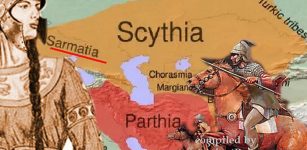 Amage: Sarmatian Warrior Queen/Regent Who Impressed With Remarkable Military Skills
Featured Stories | May 23, 2023
Amage: Sarmatian Warrior Queen/Regent Who Impressed With Remarkable Military Skills
Featured Stories | May 23, 2023 -
 Legendary ‘Orichalcum Metal’ Related To Atlantis Found In 2,600-Year-Old Shipwreck
Archaeology | Mar 3, 2017
Legendary ‘Orichalcum Metal’ Related To Atlantis Found In 2,600-Year-Old Shipwreck
Archaeology | Mar 3, 2017


